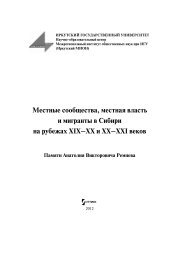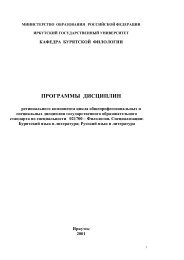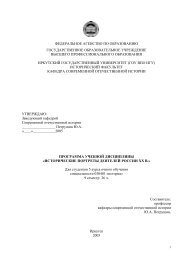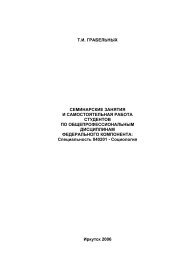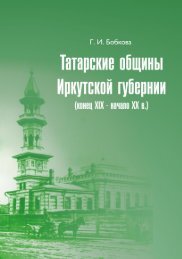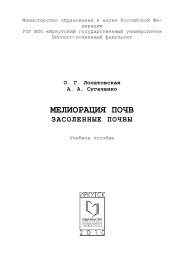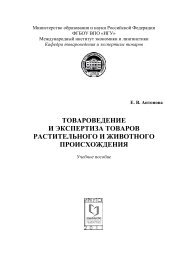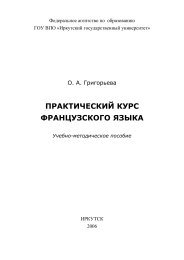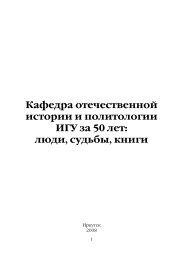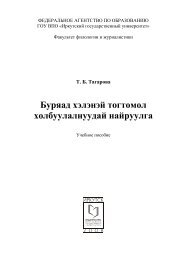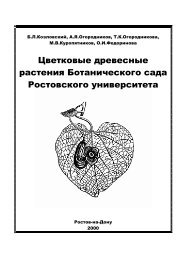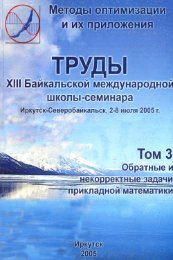Difference-differential Equations with Fredholm Operator in the Main ...
Difference-differential Equations with Fredholm Operator in the Main ...
Difference-differential Equations with Fredholm Operator in the Main ...
You also want an ePaper? Increase the reach of your titles
YUMPU automatically turns print PDFs into web optimized ePapers that Google loves.
6 Conclusion<br />
In regular case, when <strong>the</strong> operator <strong>in</strong> <strong>the</strong> lead<strong>in</strong>g part of degenerate equation is cont<strong>in</strong>uously<br />
<strong>in</strong>vertible, we can apply for <strong>in</strong>vestigation <strong>the</strong> well-known methods [2]. In irregular<br />
case, <strong>the</strong> problems stated for such equations <strong>in</strong> <strong>the</strong> standard way <strong>in</strong> general have no<br />
classical solutions [6]. It was shown <strong>in</strong> [6] that <strong>the</strong> solvability depends on <strong>the</strong> lowest<br />
terms. Thus, <strong>the</strong> question on <strong>in</strong>fluence of <strong>the</strong> lowest terms is important for statement<br />
of <strong>the</strong> boundary value problems <strong>in</strong> <strong>the</strong> <strong>the</strong>ory of difference- <strong>differential</strong> equations <strong>with</strong> a<br />
non<strong>in</strong>vertible operator <strong>in</strong> <strong>the</strong> lead<strong>in</strong>g part.<br />
Correct statement of boundary value problems for partial <strong>differential</strong> equations and<br />
difference equations <strong>with</strong> <strong>Fredholm</strong> operator <strong>in</strong> <strong>the</strong> split lead<strong>in</strong>g part and <strong>the</strong>ir <strong>in</strong>vestigations<br />
can be simplified significantly if to f<strong>in</strong>d a reasonable projection of <strong>the</strong> solution<br />
onto subspaces <strong>in</strong> accordance <strong>with</strong> properties of <strong>the</strong> Jordan structure of <strong>the</strong> operator<br />
coefficients of <strong>the</strong> equation [6], [9], [10].<br />
In general, <strong>the</strong> choice of boundary conditions for equation (1) which supply <strong>the</strong> existence<br />
of <strong>the</strong> unique classical solution for arbitrary f(x) is difficult. So, we need to extend<br />
<strong>the</strong> class of solutions, where we seek for <strong>the</strong> boundary value problem solutions of equation<br />
(1). For example, we can suppose that coefficients of projection P u are <strong>the</strong> elements<br />
of <strong>the</strong> distributions space. This extended notion of <strong>the</strong> solution for equation (1) when<br />
x ∈ R 1 was <strong>in</strong>vestigated <strong>in</strong> [8].<br />
The method proposed <strong>in</strong> this paper of reduction of equation (1) to regular problems<br />
can be applied to <strong>in</strong>vestigation <strong>in</strong> <strong>the</strong> case, when operator coefficients of equation (1)<br />
depend of x.<br />
7 Acknowledgments<br />
We thank Dirk Roose for his very significant advises dur<strong>in</strong>g preparation of this paper. The<br />
second author is greatful to Maurice Bruynooghe and Danny De Shreye for <strong>the</strong> possibility<br />
to visit KULeuven.<br />
References<br />
[1] K.T.Ahmedov, Analytical Method by Nekrasov-Nazarov <strong>in</strong> Nonl<strong>in</strong>ear Analysis. Uspekhi<br />
Mat.Nauk, 1957, v.12, no.4, p.135-155.<br />
[2] A.W.Bitsadze, Some Classes of Partial Differential <strong>Equations</strong>, ”Nauka”,<br />
Moscow,1981.<br />
[3] E.Di Benedetto and R.E.Showalter. Implicit degenerate evolution equations and <strong>the</strong>ir<br />
applications. SIAM J.Math.Anal. 1981, v.12, N5, 731-751.<br />
[4] B.V.Log<strong>in</strong>ov, Ju.B.Rusak, Generalized Jordan Structure <strong>in</strong> <strong>the</strong> Problem of <strong>the</strong> Stability<br />
of Bifurcat<strong>in</strong>g Solutions. Nonl<strong>in</strong>ear Analysis, Theory, Methods and Applications,<br />
vol.17, 3, pp.219-232, 1991.<br />
[5] M.Zuhair Nashed, Generalized Inverses and Applications (Proc.Adv.Sem., Madison,<br />
Wisc., 1973), Academic Press, New York, 1976.<br />
10



